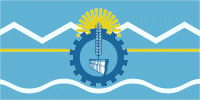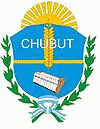Chubut Province (Chubut Province)
 |
 |
The largest city is Comodoro Rivadavia in the south of the province; it has 180,000 inhabitants. The administrative capital is Rawson (40,000). Other important cities are Puerto Madryn, Trelew, Esquel and Sarmiento. Gaiman is a cultural and demographic centre of the region known as "Y Wladfa" in which Welsh-Argentines are concentrated. Of the 25,000 Welsh speakers in Argentina, 5,000 live in the Chubut region, particularly in the early Welsh settlements of Gaiman, Trelew and Trevelin.
Before the Spaniards arrived in the Americas, nomadic indigenous Tehuelche people had inhabited the Patagonia region for thousands of years. They lived as hunter-gatherers and covered territory in seasonal cycles as they followed game.
In the 17th and 18th centuries, Spanish missionaries came to the area, and founded the San José Fort on Península Valdés. The indigenous people later destroyed it.
In 1865, Welsh people came to Chubut on the Mimosa and settled in the Chubut Valley. The region was disputed between Chile and Argentina until 1881. Chile renounced its claim in order to prevent Argentina from entering into the War of the Pacific, in which it was already fighting against Peru and Bolivia.
As part of the Conquista del Desierto (Conquest of the Desert), Argentina organized the National Territory of Chubut in 1884, after the last indigenous cacique, Inacayal, surrendered to government forces. Luis Fontana was named governor. At the beginning of the 20th century, after the Boer War, some Boer people settled in the town of Sarmiento and in lesser number in other nearby towns.
From 1895 to 1915 hundreds of Spanish and Italian born immigrantes settled in the lower Chubut valley as well a little more than hundred Chileans.
In 1944, the southern part of Chubut and northern part of Santa Cruz were designated the Comodoro Rivadavia Military Zone. The zone was dissolved in 1955, and Chubut was declared a province. Studies in the 1950s revealed mineral wealth in the province, which the government has tried to develop.
Population shifts of the late 20th century, especially from Buenos Aires, raised the population steadily from 190,000 (1970), to 357,000 (1991) and 413,237 (2001). The government has encouraged people to resettle here. Most of the inhabitants are in the main cities. They have also settled along the Chubut River. Most areas have a population density of less than 1 inhabitant per square kilometer.
Map - Chubut Province (Chubut Province)
Map
Country - Argentina
 |
 |
| Flag of Argentina | |
The earliest recorded human presence in modern-day Argentina dates back to the Paleolithic period. The Inca Empire expanded to the northwest of the country in Pre-Columbian times. The country has its roots in Spanish colonization of the region during the 16th century. Argentina rose as the successor state of the Viceroyalty of the Río de la Plata, a Spanish overseas viceroyalty founded in 1776. The declaration and fight for independence (1810–1818) was followed by an extended civil war that lasted until 1861, culminating in the country's reorganization as a federation. The country thereafter enjoyed relative peace and stability, with several waves of European immigration, mainly Italians and Spaniards, radically reshaping its cultural and demographic outlook; over 60% of the population has full or partial Italian ancestry, and Argentine culture has significant connections to Italian culture.
Currency / Language
| ISO | Currency | Symbol | Significant figures |
|---|---|---|---|
| ARS | Argentine peso | $ | 2 |
| ISO | Language |
|---|---|
| EN | English language |
| FR | French language |
| DE | German language |
| GN | Guarani language |
| IT | Italian language |
| ES | Spanish language |















